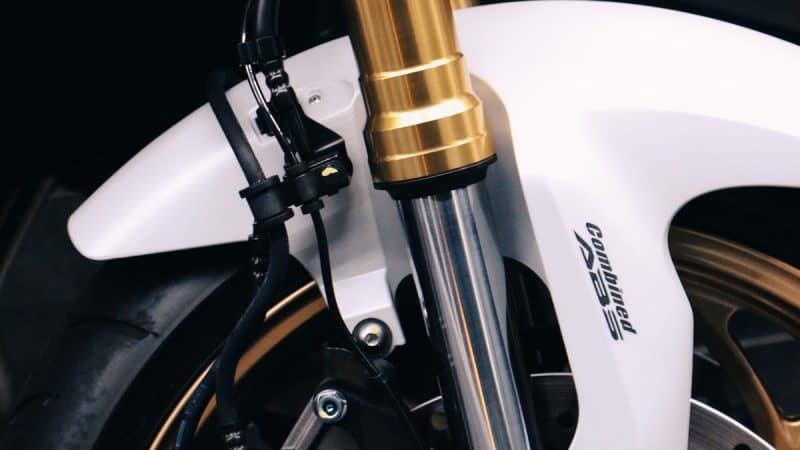Table of Contents Show
The maintenance of forks has to be taken into consideration without any excuses for a motorcycle’s suspension to work in optimal condition. Lucky for us, fork oil is a prime factor and solution for fork maintenance.
When it comes to motorcycle forks, there are no suitable alternatives for fork oil. Because it is one of the most compressible fluids formulated precisely to handle a high amount of load generated from compression and decompression of forks caused by breaking.
Due to its strong sliding properties, fork oil is a far superior & safe option to use in your motorcycles.
Do Other Alternatives Works As Good As Fork Oil?
Most of you have heard about ATF (automatic transmission fluid), hydraulic fluid, gear oil, but are they compatible enough to use instead of fork oil.
ATF ( automatic transmission fluids ) is designed for torque converts which provide lubricants for the torque converter components such as stater, turbine, and clutch assembly. And it is used predominantly in four-wheel vehicles ( i.e cars, trucks, etc ). So it’s not a safe bet to use it in our motorcycle.
Hydraulic oil is designed in a manner that it can lift heavy loads and move slowly due to its high viscosity. It is primarily used in ( construction machinery ) for its high foam resistance, oxidation stability, compressibility, thermal stability, etc. Due to its viscous properties, it is not optimal for fast and quick fork movements.
And for gear oil, it’s designed for the smooth transition between the gears. Its only objective is to lubricate the moving mesh and the gears.
Fork oil is designed to provide smooth compression and retraction to the fork piston while avoiding rapid heating. It is specifically used for the lubrication of motorcycle forks, shock absorbers, suspension struts, and other spring elements.
So avoid using any other alternatives lubricants and oils for your motorcycle forks. Go through your user manual and be aware of your surroundings where you ride while choosing your fork oil.
What Is Motorcycle Fork Oil & Its Use
If your living under a rock and don’t know about fork oil and its primary use. Don’t worry about it, we got your back. Most people will try to find alternatives for fork oil due to budget or having less knowledge about its application. What is motorcycle fork oil and why it is used in motorcycles?
Motorcycle fork oil is a lubricant that smoothens the motion of the entire suspension system, conditions the seals and parts such as fork spring, damping rod, cartridge, moving pistons, outer fork, and inner fork. It ensures that there is no corrosion and wears as lubricant avoids oxidation of the components.
Fork oil is a complex chemical lubricant used to reduces the friction between the moving parts of the fork, hence providing a smooth ride.
It prevents build-up and deposits of dirt and rust, resulting in less friction and wear of the moving components. The best part about fork oil is that it provides lubricant without forming air entrainment ( tiny air bubbles ) and foaming.
If the lubrication is not adequate, the seal of the motorcycle gets hard. Eventually, after heavy usage friction reaches a point where it surpasses the thermodynamic heat limit of the seals. This process can cause the seal to break and no longer be suitable for further use.
How To Change Motorcycle’s Fork Oil
Changing fork oil is a simple task for a rider who is experienced in fixing his or her motorcycle. For other folks who want to do it by themselves without any prior knowledge can turn out to be a difficult task. So how to change fork oil in your motorcycle?
As a general rule, measure the height above the triple clamp. Then loosen the triple clamp or yoke bolt. Now pull the fork out by hand or light wrench. Discard the old oil and pour new fork oil inside the forks at the recommended level. Put the forks back onto the motorcycle and tighten the bolts.
Once you do this process, it will be easier the next time you do it. And in no time, you will be perfect at it. But if you want a step-by-step process of how to change a motorcycle’s fork oil. We got you covered!
Here’s a step-by-step process to change fork oil in your motorcycle.
- Measure the height above the triple clamp so while installing it, you put it in the same place.
- Loosen the triple clamp bolt or yoke bolt and pull the forks out using your hands or light wrench gently without scratching it.
- After removing the forks from the motorcycle. Clean the inner forks, as there are chances of dust and stains on them.
- Clean it with a cloth. If the stains are stubborn and won’t come off easily use 400grit paper by applying light tumb pressure and move it back and forth ( the motion should be around the tube not up and down).
- Unscrew the cap by twisting it with your hands. Now pour the old fork oil into the jug or container. Be sure that the fork gets rid of all the old fork oil that might be left in the inner cartridge by pumping the fork cap with your body weight. Repeat the process a couple of times until you don’t feel any hydraulic resistance.
- Now pour the new fork oil in a jar with measuring units on it. Pour the oil slowly into the fork as recommended by the OEM ( Original equipment manufacturer, User Manual ).
- Once the poring is complete rotate the fork cap anticlockwise until you hear a clicking sound, which means that the threads are engaged but not fully closed. Screw it in ( twist the fork onto the fork cap till it gets fully tightened )
- After Closing the cap onto the fork keep the fork upright & pump it few times to get the air out of it.
- That’s all folks, the procedure is complete. Now you can enjoy smooth suspension travel.
Front Fork Oil Level (Capacity) & How Often You Should Change It.
Maintaining recommended levels of fork oil in the fork should be at the top of your list. And changing it from time to time keeps your forks in proper working condition.
Most of the motorcycle uses 450 to 740 ml fork oil level per suspension. Fork oil should be changed after every 8,000 – 10,000 miles or every 1.5 years. You should check the feel of the forks if the damping is not adequate. It indicates that the fork oil has lost its efficiency and demands replacement.
To know how much fork oil should be added to your motorcycle forks, refer to a user manual provided by the O.E.M. ( Original equipment manufacturer ).
Before changing fork oil, let’s understand the basics.
Most of the fork oils in the market come with the number for i.e – 5W, 10W, 15W, 20W. In this scenario, W indicates the viscosity(thickness or density). If the number is higher, the more viscous it is.
Low-grade fork oil flows faster than high-grade fork oils. So in the winter season, low grades oil is recommended because it won’t freeze up easily. And in the summer season, high-grade fork oil is recommended as it won’t evaporate faster due to its high viscosity and strong chemical bonds. The Grading(W) varies from brand to brand, and oil change intervals depend on the riding style.
For instance, if a rider performs an excessive amount of harsh braking combined with consistent high reviving will heat up the fork oil more in one hour compared to a passive rider.
Note: There are two indicators to determine the quality of the fork oil. Antistroke(CST) indicates gravity, and the other is kinematic viscosity(mm²/s) which indicates thermodynamics. Oil flow will be based on heat and viscosity. So depending on which weather you live in, your fork oil recommendation changes. As a general rule, use low-grade fork oils for the winter season and high-grade for the summer season.
Conclusion
There are no suitable alternatives for fork oil in the market, so stop trying to find one. Keeping the proper level of fork oil in the forks can be found on the original equipment manufacturer, and changing it from time to time should be ignored. Buy a compatible fork oil for your motorcycle by referring to your user manual and enjoy your silky smooth ride.







